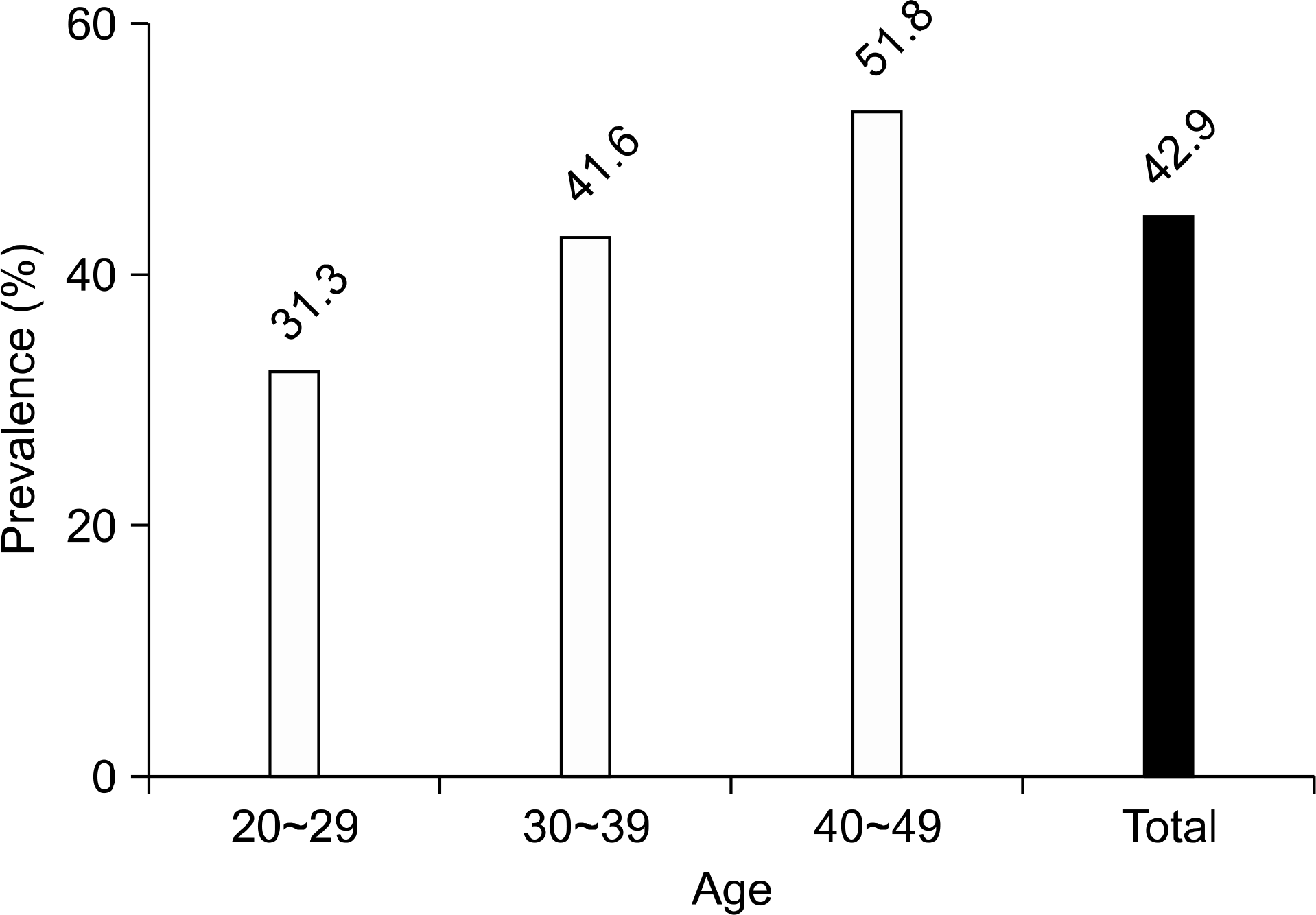Abstract
Purpose
To estimate the prevalence of and factors associated with female sexual dysfunction (FSD) in Korean women.
Materials and Methods
A total of 629 married women in the Chonnam and Gwangju area were randomly included in this study. They were asked to complete a questionnaire on FSD, which consisted of the Female Sexual Function Index (FSFI), as well as psychological, physiological, and demographic factors.
Results
The mean age of the women was 36.97 years and the mean FSFI score was 25.56 out of a total score of 36. Based on the total FSFI score, 42.9% of the women had scores less than the cutoff point of 25, the assessed definition of FSD. The prevalence of FSD by age group was: 31.3% for 20∼29 year olds, 41.6% for 30∼39 year olds, and 51.8% for 40∼49 year olds. A stepwise regression analysis found that women with higher levels of sexual distress, lower frequency of sexual intercourse, lower levels of life satisfaction, a less important appraisal of sex, a higher likelihood of depression, more conservative attitude toward sex, irregular menstrual cycle, higher age, chronic disease, and a smoking habit were more likely to suffer from FSD.
Go to : 
REFERENCES
1). Keskin U, Coksuer H, Gungor S, Ercan CM, Karasahin KE, Baser I. Differences in prevalence of sexual dysfunction between primary and secondary infertile women. Fertil Steril. 2011; 96:1213–7.

2). Laumann EO, Paik A, Rosen RC. Sexual dysfunction in the United States: prevalence and predictors. JAMA. 1999; 281:537–44.
3). Burri A, Spector T. Recent and lifelong sexual dysfunction in a female UK population sample: prevalence and risk factors. J Sex Med. 2011; 8:2420–30.

4). Basson R. Women's sexual dysfunction: revised and expanded definitions. CMAJ. 2005; 172:1327–33.

5). Goshtasebi A, Vahdaninia M, Rahimi Foroshani A. Prevalence and potential risk factors of female sexual difficulties: an urban Iranian population-based study. J Sex Med. 2009; 6:2988–96.

6). Laumann EO, Nicolosi A, Glasser DB, Paik A, Gingell C, Moreira E, et al. Sexual problems among women and men aged 40-80 y: prevalence and correlates identified in the Global Study of Sexual Attitudes and Behaviors. Int J Impot Res. 2005; 17:39–57.

7). Moreira ED Jr, Kim SC, Glasser D, Gingell C. Sexual activity, prevalence of sexual problems, and associated help-seeking patterns in men and women aged 40-80 years in Korea: data from the Global Study of Sexual Attitudes and Behaviors (GSSAB). J Sex Med. 2006; 3:201–11.
8). Cayan S, Akbay E, Bozlu M, Canpolat B, Acar D, Ulusoy E. The prevalence of female sexual dysfunction and potential risk factors that may impair sexual function in Turkish women. Urol Int. 2004; 72:52–7.

9). Safarinejad MR. Female sexual dysfunction in a population-based study in Iran: prevalence and associated risk factors. Int J Impot Res. 2006; 18:382–95.

10). Witting K, Santtila P, Varjonen M, Jern P, Johansson A, von der Pahlen B, et al. Female sexual dysfunction, sexual distress, and compatibility with partner. J Sex Med. 2008; 5:2587–99.
11). Humphery S, Nazareth I. GPs' views on their management of sexual dysfunction. Fam Pract. 2001; 18:516–8.

12). Aslan E, Beji NK, Gungor I, Kadioglu A, Dikencik BK. Prevalence and risk factors for low sexual function in women: a study of 1,009 women in an outpatient clinic of a university hospital in Istanbul. J Sex Med. 2008; 5:2044–52.

13). Sidi H, Puteh SE, Abdullah N, Midin M. The prevalence of sexual dysfunction and potential risk factors that may impair sexual function in Malaysian women. J Sex Med. 2007; 4:311–21.
14). Song SH, Jeon H, Kim SW, Paick JS, Son H. The prevalence and risk factors of female sexual dysfunction in young korean women: an internet-based survey. J Sex Med. 2008; 5:1694–701.

15). Sipski ML, Behnegar A. Neurogenic female sexual dysfunction: a review. Clin Auton Res. 2001; 11:279–83.

16). Hayes RD, Dennerstein L, Bennett CM, Koochaki PE, Leiblum SR, Graziottin A. Relationship between hypoactive sexual desire disorder and aging. Fertil Steril. 2007; 87:107–12.

17). Kim HY, So HS, Park KS, Jeong SJ, Lee JY, Ryu SB. Development of the Korean-version of female sexual function index (FSFI). Korean J Androl. 2002; 20:50–6.
18). Lee YH, Song JY. A study of the reliability and the validity of the BDI, SDS, and MMPI-D scales. Korean J Clin Psychol. 1991; 10:98–113.
19). Han C, Kim HC, Kang SH, Moon DG, Kim JJ, Choi JY. Validity and reliability of Korean version of the female sexual distress scale (FSDS). Korean J Androl. 2004; 22:68–74.
20). Fugl-Meyer AR, Lodnert G, Bränholm IB, Fugl-Meyer KS. On life satisfaction in male erectile dysfunction. Int J Impot Res. 1997; 9:141–8.

21). Oksuz E, Malhan S. Prevalence and risk factors for female sexual dysfunction in Turkish women. J Urol. 2006; 175:654–8.

Go to : 
Table 1.
General categorical variables of participants, n (%)
Table 2.
Female sexual function scores from each functional domain of FSFI by age group
Table 3.
Psychological factors according to sexual function status
Table 4.
Factors associated with FSD analyzed by stepwise regression analysis




 PDF
PDF ePub
ePub Citation
Citation Print
Print



 XML Download
XML Download